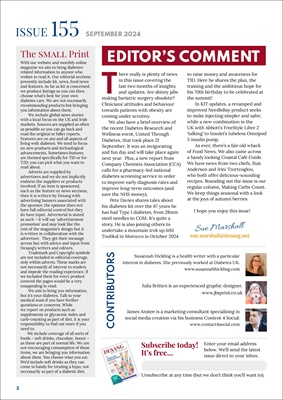
2
ISSUE 155 The DAFNE method (Dose
Adjustment for Normal
Eating) was introduced to
the UK in the year 2000, so
it will be celebrating its first quartercentury
next year. It involved a suite
of educational tools initially set up
to help people with Type 1 diabetes
to improve their understanding, and
therefore control, of their condition.
In this issue (p.tk) we look at how
things have progressed since then,
and how it has adapted to things
like Covid-19, and also the need for
educational support for people with
Type 2 diabetes.
News comes from a variety of
sources (from P.4), from fish oils,
sugar taxes, and smart socks to
artificial sweeteners.
There's a lot of KIT news in this
issue. I had the chance to interview
a beauty blogger, Ateh Jewel (p.tk),
who shared her journey following
a diagnosis of Type 2 diabetes and
subsequent use of a CGM sensor and
how that has helped her to get to
grips with her control.
EDITOR'S COMMENT
Then we report on a new CGM
from Roche's Accu-Chek brand (p.tk)
as well as examine the connected
offering called SmartMDI from
Medtronic (p.tk) for people who are
using multiple daily injections (MDI).
It links with its new Simplera Sync
sensor, newly launched her in the UK
this month (July).
Moving on to the food section
at the back of the book, we have
whipped feta, food brand Gosh, plus
Cotswolds pizza flour. We are also
assured that famous soft French
cheeses Camembert and Brie are
here to stay (phew!).
We round it all of with a Making
Carbs Count on courgettes (and their
big brother, the marrow). The recipe
for which also features whipped feta
- we are soooo on trend!
Enjoy the summer, we'll be back
at the end of September with our
next issue, taking a break in August.
sue.marshall@desang.netsue Marshall
Enter your email address
below. We'll send the latest
issue direct to your inbox.
Unsubscribe at any time (but we don't think you'll want to).
SEPTEMBER 2024
The small Print
With our website and monthly online
magazine we aim to bring diabetesrelated
information to anyone who
wishes to read it. Our editorial sections
presently include kit, news, food news
and features. As far as kit is concerned,
we produce listings so you can then
choose what's best for your own
diabetes care. We are not necessarily
recommending products but bringing
you information about them.
We include global news stories
with a local focus on the UK and Irish
markets. Sources are supplied as often
as possible so you can go back and
read the original or fuller reports.
Features are on any and all aspects of
living with diabetes. We tend to focus
on new products and technological
advancements. Sometimes features
are themed specifically for T1D or for
T2D; you can pick what you want to
read about.
Adverts are supplied by
advertisers and we do not implicitly
endorse the suppliers or products
involved. If an item is sponsored,
such as the feature or news sections,
then it is written by Desang with
advertising banners associated with
the sponsor; the sponsor does not
have full editorial control but they
do have input. Advertorial is stated
as such - it will say 'advertisement
promotion' and may look like the
rest of the magazine's design but it
is written in collaboration with the
advertiser. They get their message
across but with advice and input from
Desang's writers and editors.
Trademark and Copyright symbols
are not included in editorial coverage,
only within adverts. These marks are
not necessarily of interest to readers
and impede the reading experience. If
we included them for every product
covered the pages would be a very
unappealing to read.
We aim to bring you information,
but it's your diabetes. Talk to your
medical team if you have further
questions or concerns. While
we report on products such as
supplements or glycaemic index and
carb-counting as part of diet, it is your
responsibility to find out more if you
need to.
We include coverage of all sorts of
foods - soft drinks, chocolate, booze -
as these are part of normal life. We are
not encouraging consumption of these
items, we are bringing you information
about them. You choose what you eat.
We'd include soft drinks as they can
come in handy for treating a hypo, not
necessarily as part of a diabetic diet.
Susannah Hickling is a health writer with a particular
interest in diabetes. She previously worked at Diabetes UK.
www.susannahhickling.com
Julia Britten is an experienced graphic designer.
www.jbsprint.co.uk
James Anstee is a marketing consultant specialising in
social media creation via his business Content 4 Social:
www.contact4social.com